Charles E W Bean, Diaries, AWM38 3DRL 606/275/1 - 1918 - 1938 - Part 23
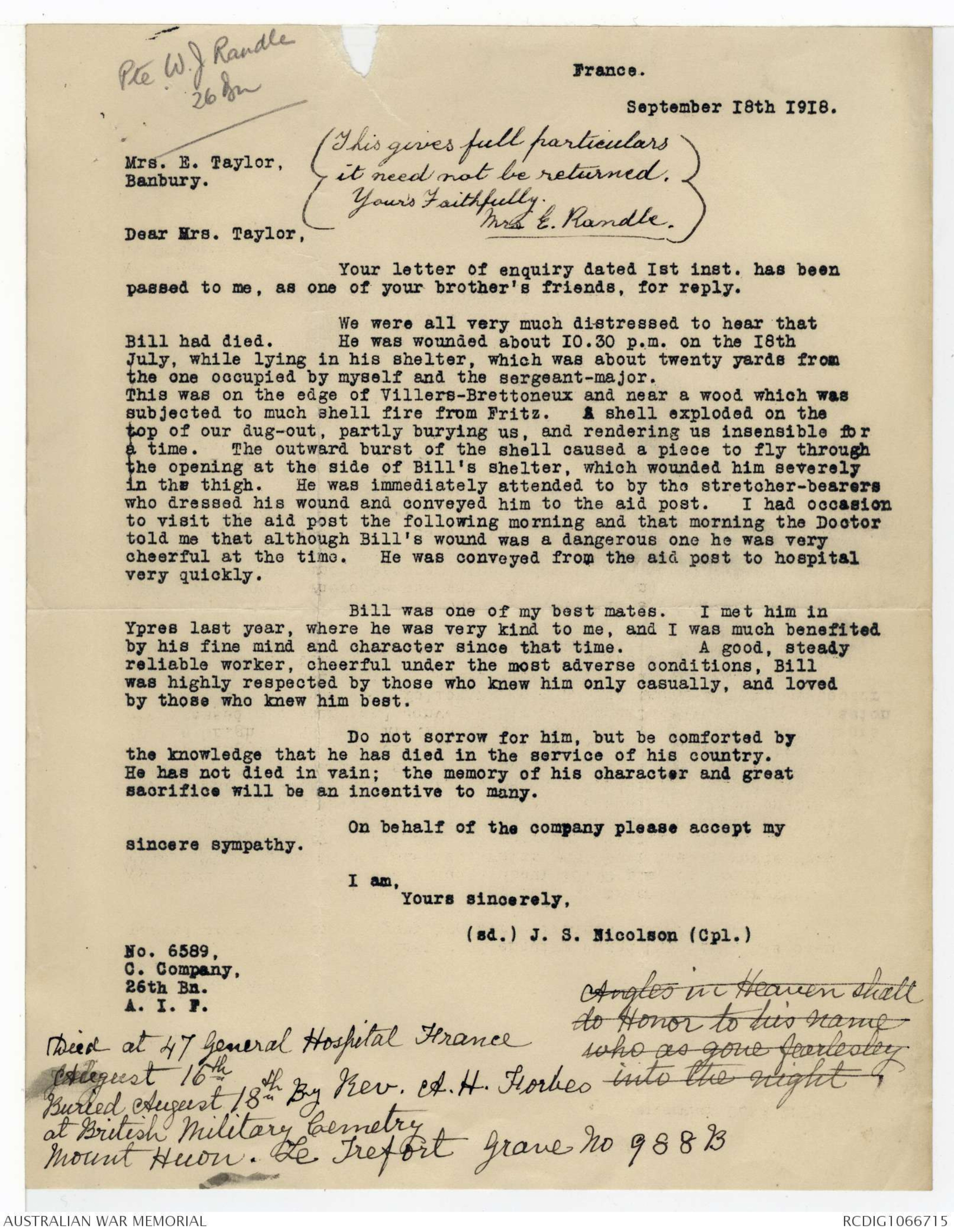
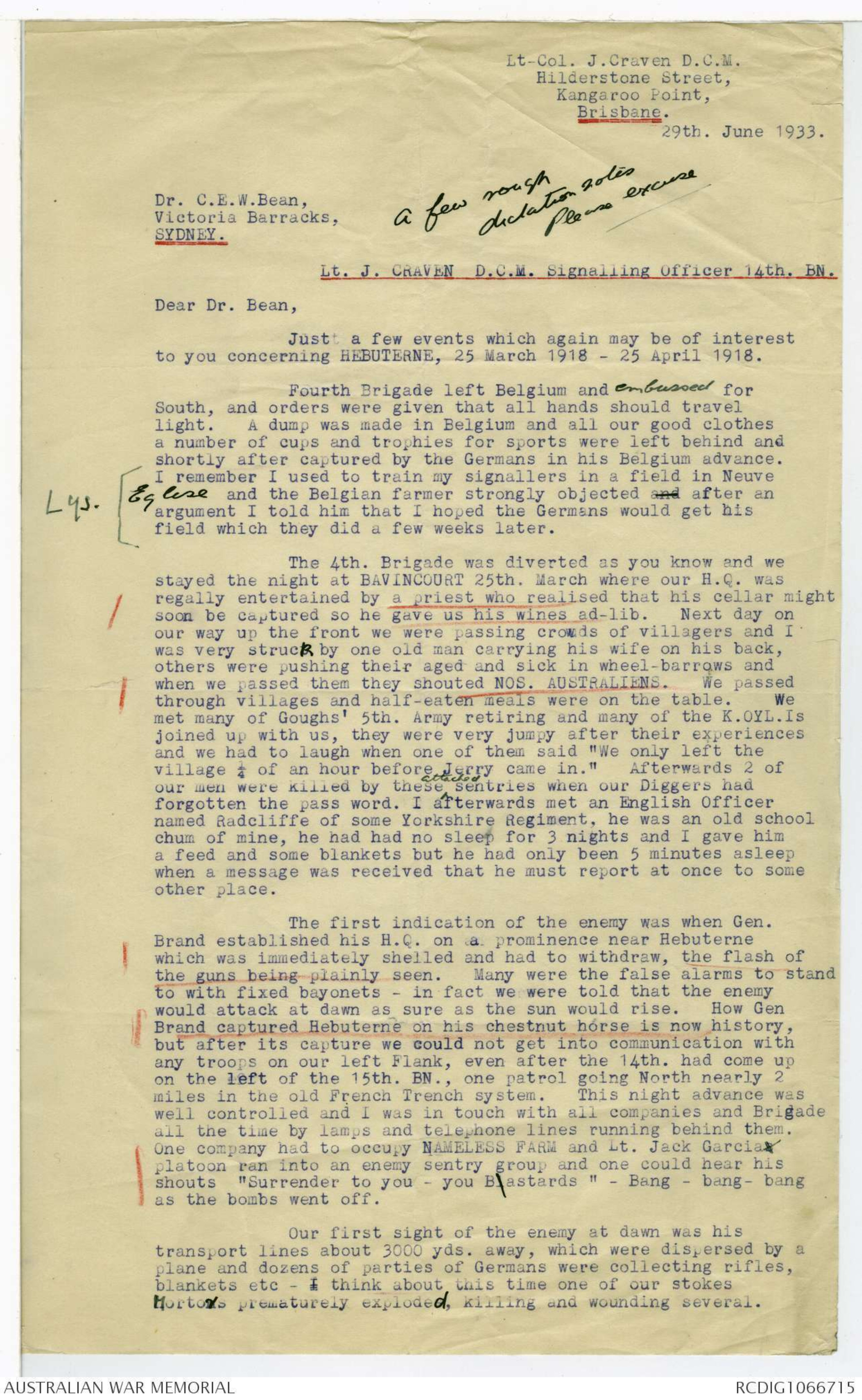
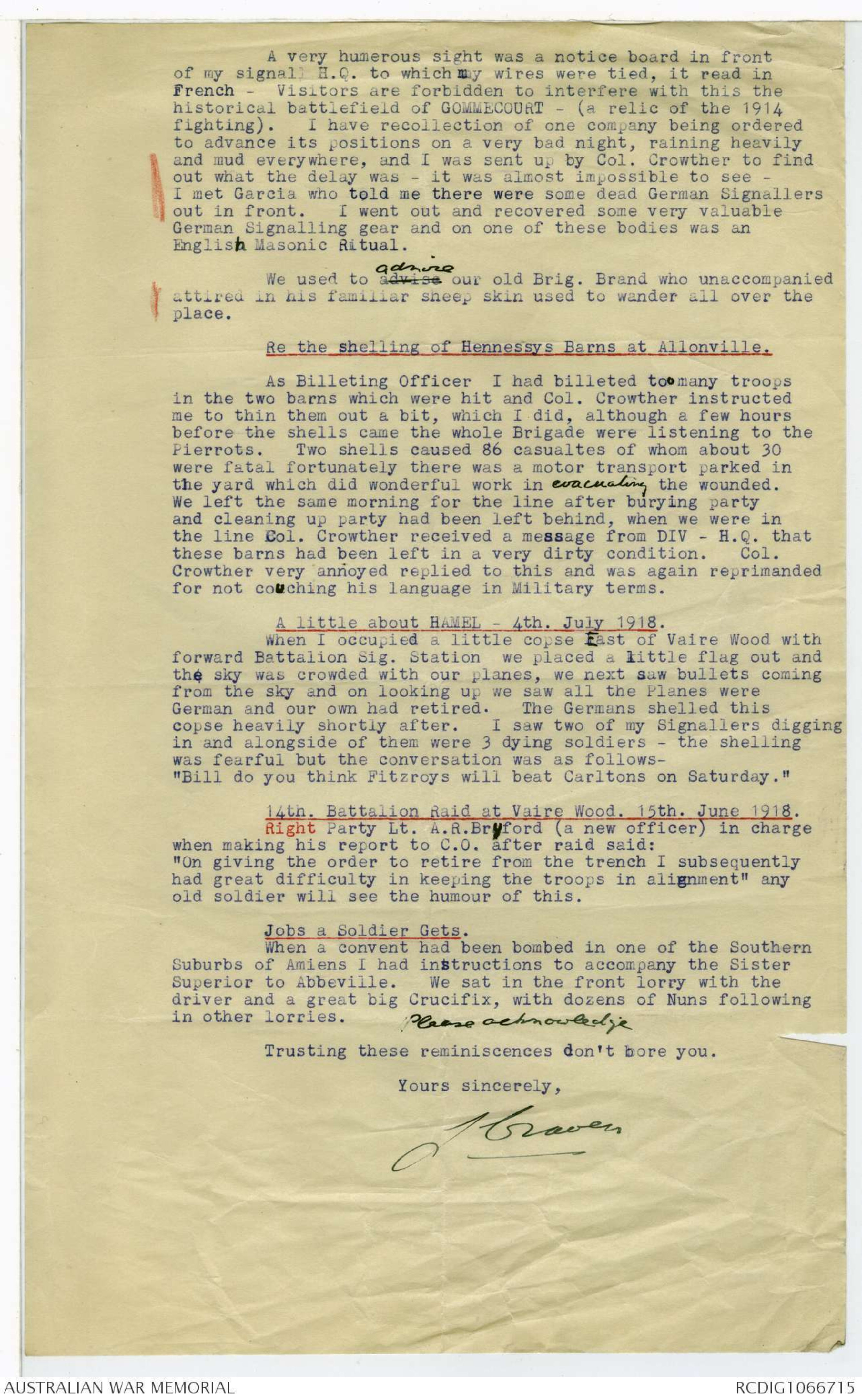
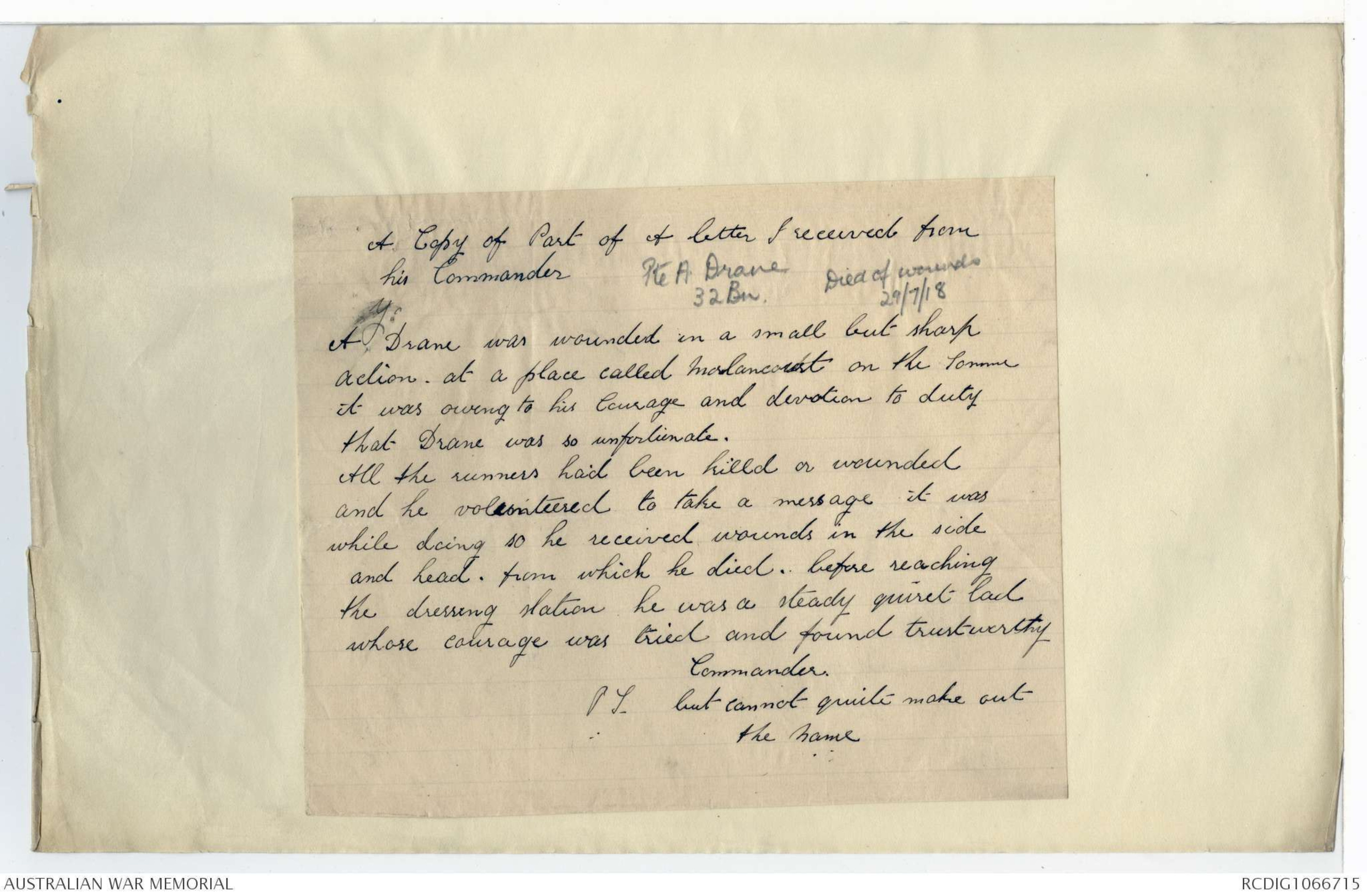
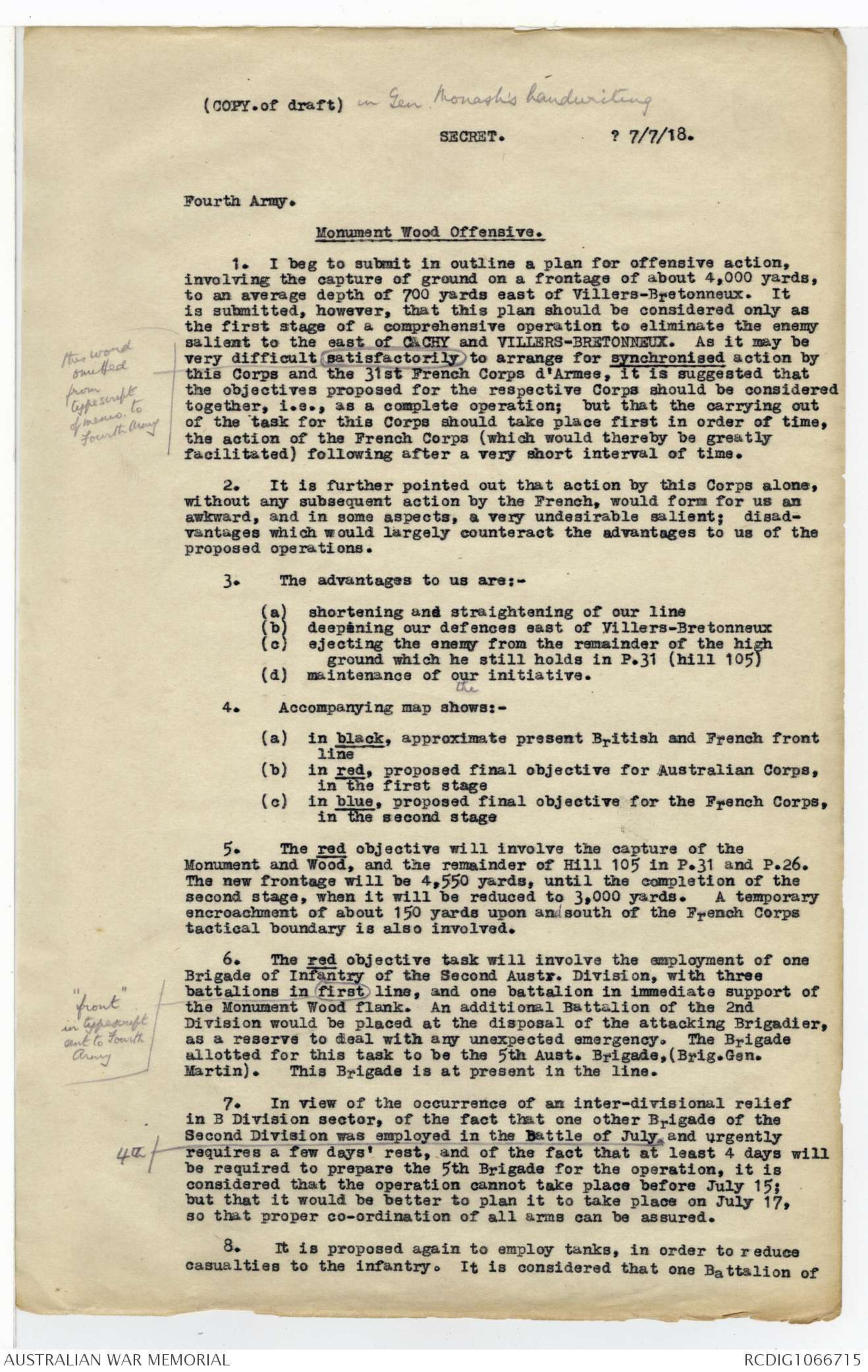


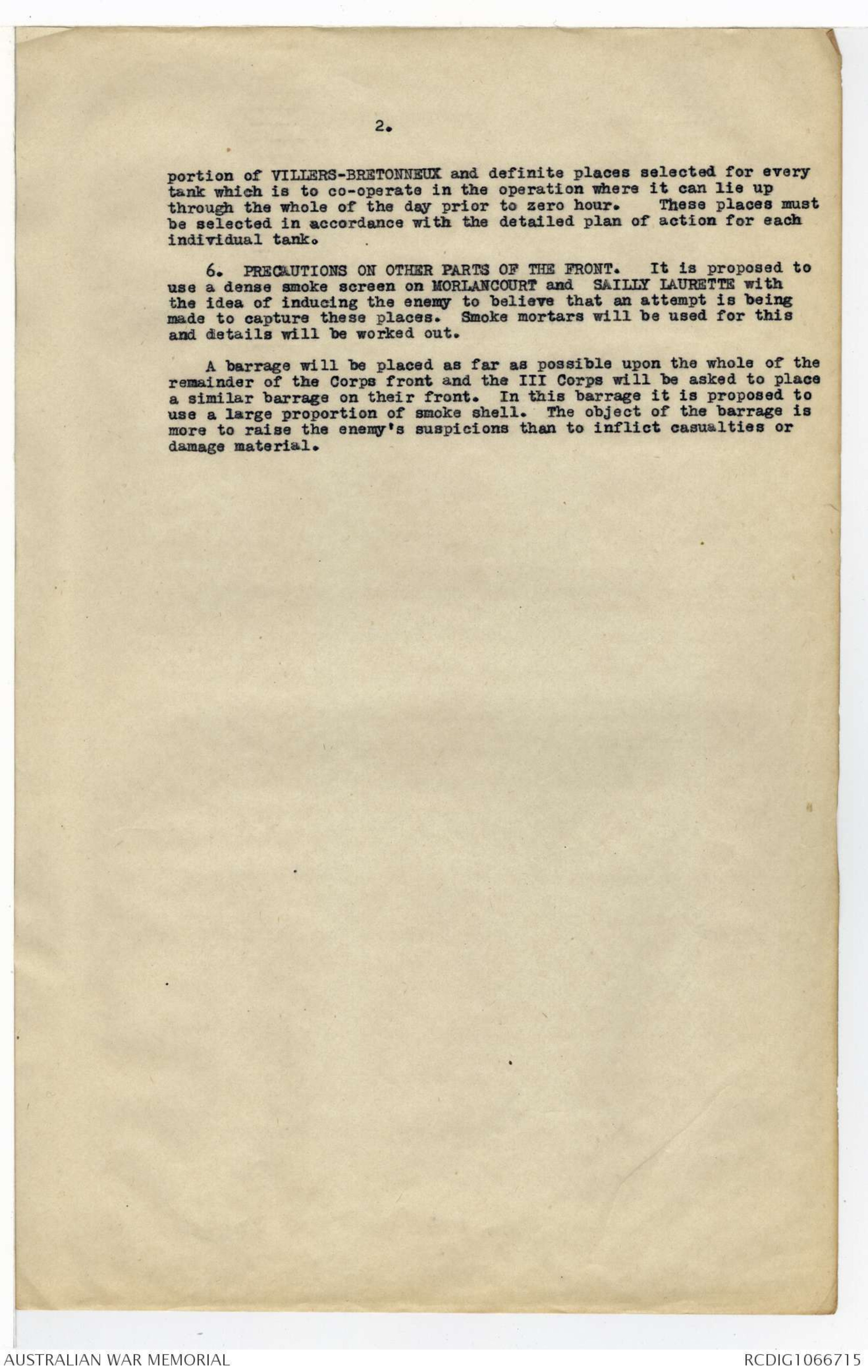

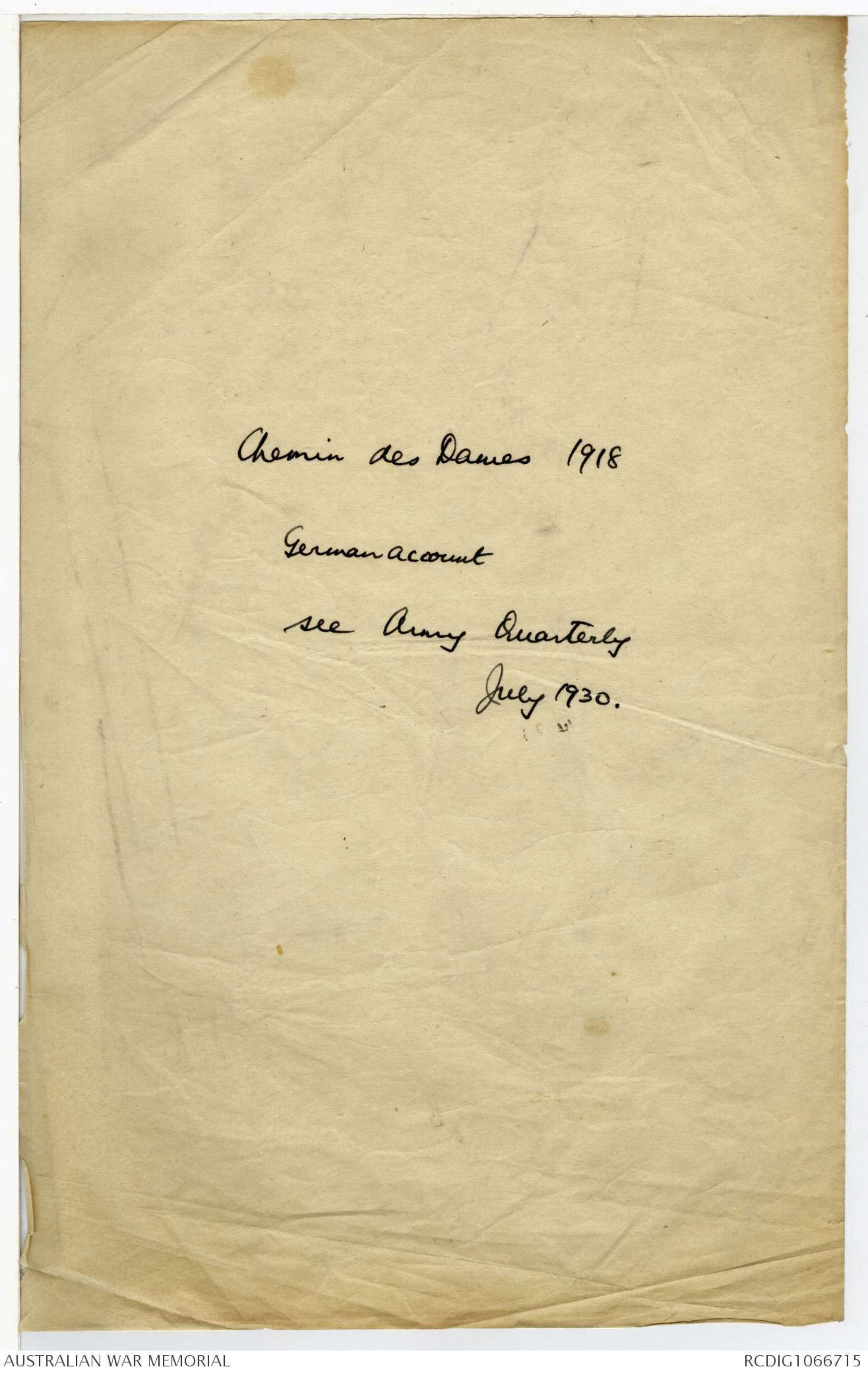
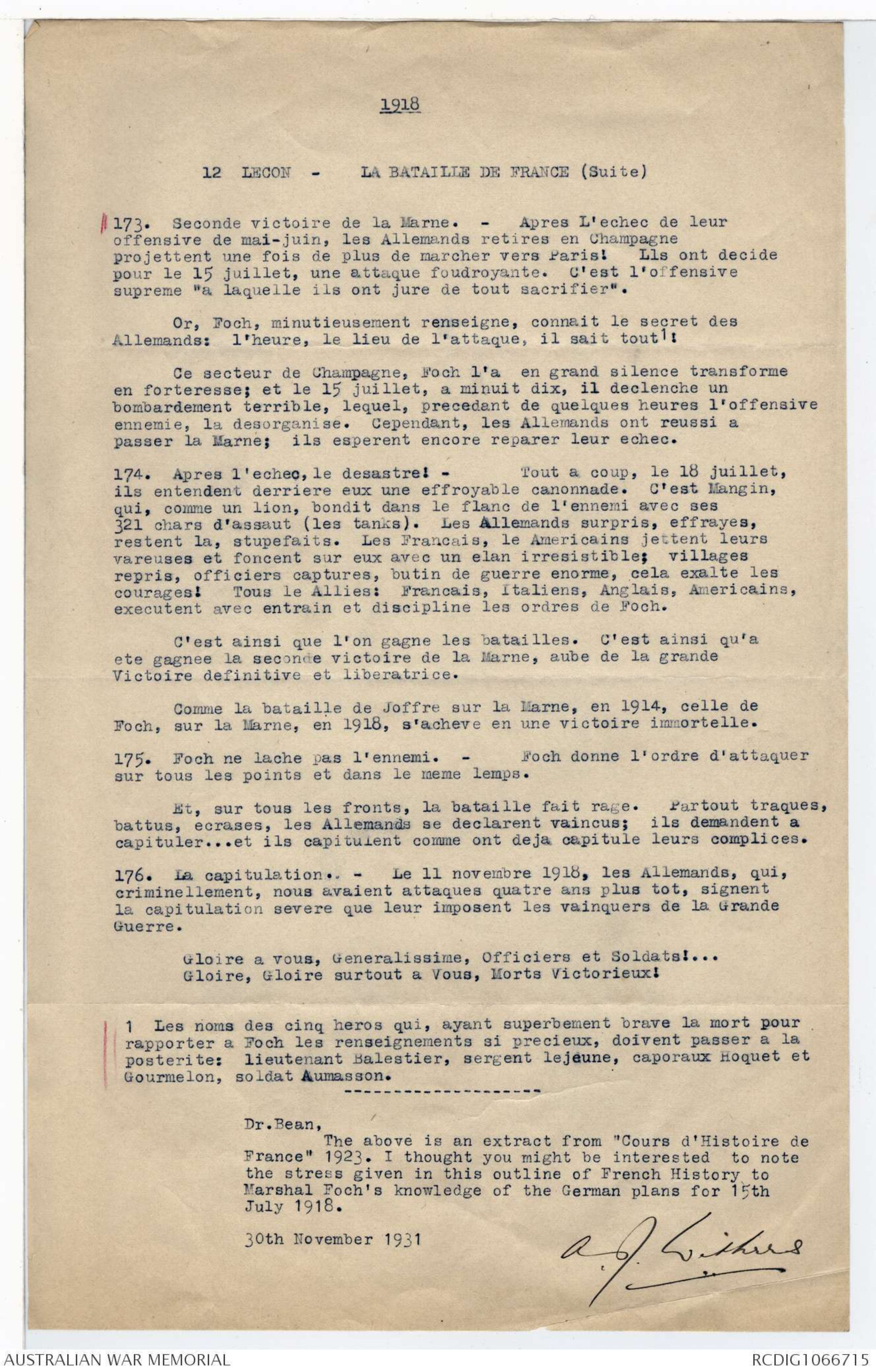
Pte W.J Randle
France.
September I8th I918.
Mrs. E. Taylor,
Banbury.
[*This gives full particulars
it need not be returned.
Yours Faithfully,
Mrs E. Randle.*]
Dear Mrs. Taylor,
Your letter of enquiry dated 1st inst, has been
passed to me, as one of your brother's friends, for reply.
We were all very much distressed to hear that
Bill had died. He was wounded about 1O.30 p.m. on the 18th
July, while lying in his shelter, which was about twenty yards from
the one occupied by myself and the sergeant-major.
This was on the edge of Villers-Brettoneux and near a wood which was
subjected to much shell fire from Fritz. A shell exploded on the
top of our dug-out, partly burying us, and rendering us insensible for
a time. The outward burst of the shell caused a piece to fly through
the opening at the side of Bill's shelter, which wounded him severely
in the thigh. He was immediately attended to by the stretcher-bearers
who dressed his wound and conveyed him to the aid post. I had occasion
to visit the aid post the following morning and that morning the Doctor
told me that although Bill's wound was a dangerous one he was very
cheerful at the time. He was conveyed from the aid post to hospital
very quickly.
Bill was one of my best mates. I met him in
Ypres last year, where he was very kind to me, and I was much benefited
by his fine mind and character since that time. A good, steady
reliable worker, cheerful under the most adverse conditions, Bill
was highly respected by those who knew him only casually, and loved
by those who knew him best.
Do not sorrow for him, but be comforted by
the knowledge that he has died in the service of his country.
He has not died in vain; the memory of his character and great
saorifice will be an incentive to many.
On behalf of the company please accept my
sincere sympathy.
I am,
Yours sincerely,
(sd.) J. S. Nicolson (Cpl.)
No. 6589
C. Company,
26th Bn.
A. I. F.
[*Died at 47 General Hospital France
August 16th
Buried August 18th By Rev. A. H. Forbes
at British Military Cemetry
Mount Huon. Le Trefort Grave no 988B*]
[*Angles in Heaven shall
do Honor to his name
who as gone fearlesley
into the night.*]
Lt-Col. J.Craven D.C.M.
Hilderstone Street,
Kangaroo Point,
Brisbane.
29th. June 1933.
Dr. C.E.W.Bean,
Victoria Barracks,
SYDNEY.
[*A few rough
dictation notes.
Please excuse*]
Lt. J. CRAVEN D.C.M. Signalling Officer 14th. BN.
Dear Dr. Bean,
Just a few events which again may be of interest
to you concerning HEBUTERNE, 25 March 1918 - 25 April 1918.
Fourth Brigade left Belgium and embussed for
South, and orders were given that all hands should travel
light. A dump was made in Belgium and all our good clothes
a number of cups and trophies for sports were left behind and
shortly after captured by the Germans in his Belgium advance.
I remember I used to train my signallers in a field in Neuve
Eglise and the Belgian farmer strongly objected after and after an
argument I told him that I hoped the Germans would get his
field which they did a few weeks later.
The 4th. Brigade was diverted as you know and we
stayed the night at BAVINCOURT 25th. March where our H.Q. was
regally entertained by a priest who realised that his cellar might
soon be captured so he gave us his wines ad-lib. Next day on
our way up the front we were passing crowds of villagers and I
was very struck by one old man carrying his wife on his back,
others were pushing their aged and sick in wheel-barrows and
when we passed them they shouted NOS. AUSTRALIENS. We passed
through villages and half-eaten meals were on the table. We
met many of Goughs' 5th. Army retiring and many of the K.OYL. Is
joined up with us, they were very jumpy after their experiences
and we had to laugh when one of them said "We only left the
village 1/4 of an hour before Jerry came in." Afterwards 2 of
our men were killed by these ^ attached sentries when our Diggers had
forgotten the pass word. I afterwards met an English Officer
named Radcliffe of some Yorkshire Regiment, he was an old school
chum of mine, he had had no sleep for 3 nights and I gave him
a feed and some blankets but he had only been 5 minutes asleep
when a message was received that he must report at once to some
other place.
The first indication of the enemy was when Gen.
Brand established his H.Q. on a prominence near Hebuterne
which was immediately shelled and had to withdraw, the flash of
the guns being-plainly seen. Many were the false alarms to stand
to with fixed bayonets - in fact we were told that the enemy
would attack at dawn as sure as the sun would rise. How Gen
Brand captured Hebuterne on his chestnut horse is now history,
but after its capture we could not get into communication with
any troops on our left Flank, even after the 14th. had come up
on the left of the 15th. BN., one patrol going North nearly 2
miles in the old French Trench system. This night advance was
well controlled and I was in touch with all companies and Brigade
all the time by lamps and telephone lines running behind them.
One company had to occupy NAMELESS FARM and Lt. Jack Garcias
platoon ran into an enemy sentry group and one could hear his
shouts "Surrender to you - you Bjastards " - Bang - bang- bang
as the bombs went off.
Our first sight of the enemy at dawn was his
transport lines about 3000 yds. away, which were dispersed by a
plane and dozens of parties of Germans were collecting rifles,
blankets etc - I think about this time one of our stokes
Mortors prematurely exploded, killing and wounding several.
A very humerous sight was a notice board in front
of my signal H.Q. to which my wires were tied, it read in
French -
Visitors are forbidden to interfere with this the
historical battlefield of GOMMECOURT - (a relic of the 1914
fighting). I have recollection of one company being ordered
to advance its positions on a very bad night, raining heavily
and mud everywhere, and I was sent up by Col. Crowther to find
out what the delay was - it was almost impossible to see
I met Garcia who told me there were some dead German Signallers
out in front. I went out and recovered some very valuable
German Signalling gear and on one of these bodies was an
English Masonic Ritual.
We used to advise advice our old Brig. Brand who unaccompanied
attired in his familiar sheep skin used to wander all over the
place.
Re the shelling of Hennessys Barns at Allonville.
As Billeting Officer, I had billeted too many troops
in the two barns which were hit and Col. Crowther instructed
me to thin them out a bit, which I did, although a few hours
before the shells came the whole Brigade were listening to the
Pierrots. Two shells caused 86 casualtes of whom about 30
were fatal fortunately there was a motor transport parked in
the yard which did wonderful work in evacuating, the wounded.
We left the same morning for the line after burying party
and cleaning up party had been left behind, when we were in
the line Col. Crowther received a message from DIV - H.Q. that
these barns had been left in a very dirty condition. Col.
Crowther very annoyed replied to this and was again reprimanded
for not couching his language in Military terms.
A little about HAMEL - 4th. July 1918.
When I occupied a little copse East of Vaire Wood with
forward Battalion Sig. Station we placed a little flag out and
the sky was crowded with our planes, we next saw bullets coming
from the sky and on looking up we saw all the Planes were
German and our own had retired. The Germans shelled this
copse heavily shortly after. I saw two of my Signallers digging
in and alongside of them were 3 dying soldiers - the shelling
was fearful but the conversation was as follows-
"Bill do you think Fitzroys will beat Carltons on Saturday."
14th. Battalion Raid at Vaire Wood. 15th. June 1918.
Right Party Lt. A.R.Bryford (a new officer) in charge
when making his report to C.O. after raid said:
"On giving the order to retire from the trench I subsequently
had great difficulty in keeping the troops in alignment" any
old soldier will see the humour of this.
Jobs a Soldier Gets.
When a convent had been bombed in one of the Southern
Suburbs of Amiens I had instructions to accompany the Sister
Superior to Abbeville. We sat in the front lorry with the
driver and a great big Crucifix, with dozens of Nuns following
in other lorries.
[*Please acknowledge*]
Trusting these reminiscences don't bore you.
Yours sincerely,
J Craven
A Copy of Part of a Letter I received from
his Commander
[*Pte A. Drane
32 Bn. Died of wounds
29/7/18*]
A. Drane was wounded in a small but sharp
action at a place called Morlancourt on the Somme
it was owing to his courage and devotion to duty
that Drane was so unfourtunate.
All the runners had been killed or wounded
and he volunteered to take a message it was
while doing so he received wounds in the side
and head, from which he died. before reaching
the dressing station he was a steady quiet lad
whose courage was treid and found trustworthy
Commander.
P.S but cannot quite make out
the name
(COPY. of draft) in Gen. Monash's handwriting
SECRET.
?7/7/18.
Fourth Army.
Monument Wood Offensive.
1. I beg to submit in outline a plan for offensive action,
involving the capture of ground on a frontage of about 4,000 yards,
to an average depth of 700 yards east of Villers-Bretonneux. It
is submitted, however, that this plan should be considered only as
the first stage of a comprehensive operation to eliminate the enemy
salient to the east of CACHY and VILLERS-BRETONNEUX. As it may be
very difficult satisfactorily
[* this word
omitted
from typescript
of memo. to
Fourth Army*]
to arrange for synchronised action by
this Corps and the 31st French Corps d'Armee, it is suggested that
the objectives proposed for the respective Corps should be considered
together, i.e., as a complete operation; but that the carrying out
of the task for this Corps should take place first in order of time,
the action of the French Corps (which would thereby be greatly
facilitated) following after a very short interval of time.
2. It is further pointed out that action by this Corps alone,
without any subsequent action by the French, would form for us an
awkward, and in some aspects, a very undesirable salient; disadvantages
which would largely counteract the advantages to us of the
proposed operations.
3. The advantages to us are:-
(a) shortening and straightening of our line
(b) deepining our defences east of Villers-Bretonneux
(c) ejecting the enemy from the remainder of the high
ground which he still holds in P.31 (hill 105)
(d) maintenance of our initiative.
4. Accompanying map shows:-
(a) in black, approximate present British and French front
line
(b) in red, proposed final objective for Australian Corps,
in the first stage
(c) in blue, proposed final objective for the French Corps,
in the second stage
5. The red objective will involve the capture of the
Monument and Wood, and the remainder of Hill 105 in P.31 and P.26.
The new frontage will be 4,550 yards, until the completion of the
second stage, when it will be reduced to 3,000 yards. A temporary
encroachment of about 150 yards upon and south of the French Corps
tactical boundary is also involved.
6. The red objective task will involve the employment of one
Brigade of Infantry of the Second Austr. Division, with three
battalions in first
[* "front"
in typescript
sent to Fourth
army*]
line, and one battalion in immediate support of
the Monument Wood flank. An additional Battalion of the 2nd
Division would be placed at the disposal of the attacking Brigadier,
as a reserve to deal with any unexpected emergency. The Brigade
allotted for this task to be the 5th Aust. Brigade, (Brig.Gen.
Martin). This Brigade is at present in the line.
7. In view of the occurrence of an inter-divisional relief
in B Division sector, of the fact that one other Brigade of the
Second Division was employed in the Battle of July, and urgently
requires a few days' rest, and of the fact that at least 4 days will
be required to prepare the 5th Brigade for the operation, it is
considered that the operation cannot take place before July 15;
but that it would be better to plan it to take place on July 17,
so that proper co-ordination of all arms can be assured.
8. It is proposed again to employ tanks, in order to reduce
casualties to the infantry. It is considered that one Battalion of
2.
Tanks should be held in readiness for employment, including supports
and reserves, and counter-attack tanks. Probably 21 or 24 Tanks will
be sufficient in the actual advance with the Infantry.
9. It is also proposed to employ a normal advancing Artillery
Barrage. The frontage will require 9 Brigades of Field Artillery,
all of which could, if obligatory, be provided from Corps resources,
but the loan of 2 Brigades of Field Artillery from Army resources
would materially simplify the Artillery dispositions, and obviate any
encroachment upon the xxxxx normal Artillery defences of the Corps.
10. All other subsidiary arrangements would be on normal lines,
i.e., Counter-battery work, M.G. barrages, use of smoke, employment
of aircraft, etc. etc. None of these matters would present any
difficulty.
11. Very special attention will have to be given to the working
out of plans to disguise our preparations, and to conceal during
battle the actual frontage of the attack, with a view to dislocating
the enemy Artillery reaction. It is hoped that, in this, novel
expedients will suggest themselves, after fuller consideration of the
matter.
12. As, in viewxof the necessity for secrecy, I have refrained
from discussing these proposals, in detail, with any of my subordinate
commanders concerned, they must be regarded, for the present, as
tentative only, and subject to modification in detail.
Lt.Gen.
Commanding Australian Corps.
[*With two ^ minor exceptions noted in the margin of page 1,
this draft memo ^ as drafted, was sent on 7/7/18 to Fourth
Army. No. G 8/7.
The map referred to is filed in Vol. 19 of
Gen. Monash's records.
COPY.
Conference of 11/7/18.
PROPOSED OUTLINX OF PLAN OF OPERATIONS
MONUMENT WOOD OFFENSIVE.
1.-OBJECTIVE. The attached map shows in BLACK the present frontvline
south-east of VILLERS-BRETONNEUX. The proposed objective of the
operation is show in BLUE. The total frontage at the present date
(11th July) is 2,750 yards. The average depth of the proposed advance
is between 500 and 600 yards.
2.-TROOPS REQUIRED.
Infantry: The total number of Infantry required for the
operation is estimated at 2 battalions. It is proposed to employ the
5th A.I. Brigade for the operation.
Artillery: Total artillery required will be 7 Artillery
Brigades. These are available from present Corps resources.
Tanks: The total number of tanks required will be 2 or 3
Sections (8 to 12 tanks).
3. NATURE OF THE OPERATION. The general method of attack will be to
place an artillery smoke barrage covering the whole objective. An
artillery creeping barrage will be employed to move through the depth
of the area of advance rapidly and establish itself on an S.O.S. line
beyond the line of the proposed objective. Under cover of this the
tanks allotted for the operation will move out along the pre-determined
routes and clean up MONUMENT WOOD, ASSYRIA Trench and remaining
portion of the enemy's defensive system.
The total number of Infantry actually employed in the advance
will be reduced to what is considered the necessary minimum.
In the southern portion of the operations each party of troops
detailed to the objective will move with its own tanks. It remains
to be determined whether any tanks will move out direct against the
northern portion of the objective, as this presents difficulties in
finding concealed positions in which tanks can lie up during the day
and which are near enough to the infantry bases of departure.
It is proposed to carry out the operation in the early evening at
such an hour as will give the infantry every facility for determining
their position and consolidating the posts which will be established
before dark. It is anticipated by doing this the infantry will have
the whole night to consolidate and the enemy will be unable to
determine where to place his barrage.
This involves the necessity of placing the infantry in their
start positions on the night prior to zero and retaining them in these
positions throughout the day. It is essential that there shall be
absolutely no movement on this portion of the front throughout the
whole of the day prior to zero hour.
4. -ARTILLERY. Artillery positions will be selected in advance and
careful registration carried out under cover of the normal harassing
fire.
As soon as details of the attack are determined it is desirable
that there shall be a complete cessation of the present nibbling
tactics on this part of the front in order to give the enemy a feeling
of security and lull his suspicions.
A complete counter-battery scheme must be employed similar to
that employed on the 4th July. This counter-battery scheme must
commence at zero hour.
5.-TANKS. A careful reconnaissance must be made on the eastern
2.
portion of VILLERS-BRETONNEUX and definite places selected for every
tank which is to co-operate in the operation where it can lie up
through the whole of the day prior to zero hour. These places must
be selected in accordance with the detailed plan of action for each
individual tank.
6. PRECAUTIONS ON OTHER PARTS OF THE FRONT. It is proposed to
use a dense smoke screen on MORLANCOURT and SAILLY LAURETTE with
the idea of inducing the enemy to believe that an attempt is being
made to capture these places. Smoke mortars will be used for this
and details will be worked out.
A barrage will be placed as far as possible upon the whole of the
remainder of the Corps front and the III Corps will be asked to place
a similar barrage on their front. In this barrage it is proposed to
use a large proportion of smoke shell. The object of the barrage is
more to raise the enemy's suspicions than to inflict casualties or
damage material.
COPY.
Headquarters,
2nd Australian Division.
(General Staff)
G1/932
CONFERENCE WITH ARMY COMMANDER AND M.G.G.S. AT 5 P.M.
ON 157H JULY, 1918.
After explaining to the Army Commander the situation in the
neighbourhood of Monument Wood, the existence of the Mound in Square
V.1, and my proposals for further exploitation, easterly, along the
WARFUSEE railway, also the attitude of the French on our right flank,
he agreed to the following plan of action:
1. The trench line captured by us to-day from U.5 cent. to U.6 cent.
is to be jointly held by us and the French as an "international
trench", the French digging that portion which crosses No Man's Land.
2. We are to induce the French, with our help, to work southward
down Stamboul Trench and Craft Trench, with a view to seizing and
holding it.
3. After the occupation of this trench, the French are to be asked
to take it over and hold it without our help. The French will also
take over and hold, without our help, the trench from U.5 cent. to
the junction of Stamboul and Syria trenches, this section then
becoming merely a C.T.
4. We will then hold only the portion from the last-named intersection
as far East as U.6 cent., as an "international trench".
5. The French to have suggested to them that they should shorten
their line by establishing a line of posts from the southern end of
Craft Trench, south-westerly to their salient in U.16.a, North of
Hangard Wood.
6. Our final objective line is to run from U.6 cent., easterly to
V.1. b.6.5 and thence north-easterly to join our present front line
at the Warfusee Road at P.27.c.2.5. The territory enclosed by
this objective line which is still unoccupied by us is to be taken by
a process of minor operations and offensive patrolling, employing no
resources beyond those at the disposal of the "A" Division. This
objective line is to represent the furthest advance to the eastward
and south-eastward that we are to make for the time being, and we wil
consolidate on this line and organize defences thereon.
7. All negotiations with the French troops, to ensure their co-operation,
will, for the time being, be made by the "A" Divisional
Commander xxxxxx direct with the Regimental and Divisional Commander
of the French on the immediate flank, seeing that the Army Commander
considers it hopeless to induce the French Army Command expressly to
order these operations and arrangements.
(Intd.) J.M.
15/17/18.
Chemin des Dames 1918
German account
see Army Quarterly
July 1930.
1918
12 LECON - LA BATAILLE DE FRANCE (Suite)
173. Seconde victoire de la Marne. - Apres L'echec de leur
offensive de mai-juin, les Allemands retires en Champagne
projettent une fois de plus de marcher vers Paris! Lls ont decide
pour le 15 juillet, une attaque foudroyante. C'est l'offensive
supreme "a laquelle ils ont jure de tout sacrifier".
Or, Foch, minutieusement renseigne, connait le secret des
Allemands: l'heure, le lieu de l'attaque, il sait tout1:
Ce secteur de Champagne, Foch l’a en grand silence transforme
en forteresse; et le 15 juillet, a minuit dix, il declenche un
bombardement terrible, lequel, precedant de quelques heures l'offensive
ennemie, la desorganise. Cependant, les Allemands ont reussi a
passer la Marne; ils esperent encore reparer leur echec.
174. Apres l'echec, le desastre! - Tout a coup, le 18 juillet,
ils entendent derriere eux une effroyable canonnade. C'est Mangin,
qui, comme un lion, bondit dans le flanc de l'ennemi avec ses
321 chars d'assaut (les tanks). Les Allemands surpris, effrayes,
restent la, stupefaits. Les Français, le Americains jettent leurs
vareuses et foncent sur eux avec un elan irresistible; villages
repris, officiers captures, butin de guerre enorme, cela exalte les
courages! Tous le Allies: Francais, Italiens, Anglais, Americains,
executent avec entrain et discipline les ordres de Foch.
C'est ainsi que l'on gagne les batailles. C'est ainsi qu'a
ete gagnee la seconde victoire de la Marne, aube de la grande
Victoire definitive et liberatrice.
Comme la bataille de Joffre sur la Marne, en 1914, celle de
Foch, sur la Marne, en 1918, s'acheve en une victoire immortelle.
175. Foch ne lache pas l'ennemi. Foch donne l'ordre d'attaquer
sur tous les points et dans le meme lemps.
Et, sur tous les fronts, la bataille fait rage. Partout traques,
battus, ecrases, les Allemands se declarent vaincus; ils demandent a
capituler...et ils capitulent comme ont deja capitule leurs complices.
176. La capitulation.- Le 11 novembre 1918, les Allemands, qui,
criminellement, nous avaient attaques quatre ans plus tot, signent
la capitulation severe que leur imposent les vainquers de la Grande
Guerre.
Gloire a vous, Generalissime, Officiers et Soldats!...
Gloire, Gloire surtout a Vous, Morts Victorieux!
1 Les noms des cing heros qui, ayant superbement brave la mort pour
rapporter a Foch les renseignements si precieux, doivent passer a la
posterite: lieutenant Balestier, sergent lejeune, caporaux Hoquet et
Gourmelon, soldat Aumasson.
-------------------
Dr. Bean,
The abové is an extract from "Cours d'Histoire de
France" 1923. I thought you might be interested to note
the stress given in this outline of French History to
Marshal Foch's knowledge of the German plans for 15th
July 1918.
3Oth November 1931
[[ A.J Withers?]]
 Sam scott
Sam scottThis transcription item is now locked to you for editing. To release the lock either Save your changes or Cancel.
This lock will be automatically released after 60 minutes of inactivity.